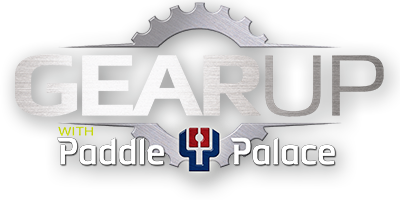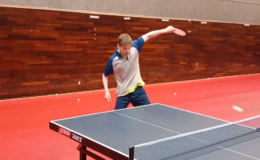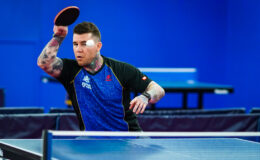By Larry Hodges, USATT Hall of Famer and Certified National Coach
One of the trickier things in table tennis starting at the intermediate level is how to return short backspin serves without giving the server an easy ball to loop. The easiest return is a long push, but then the server gets to loop. You can also flip the short serve, but that can be tricky, and many servers can loop that return as well unless you flip very aggressively – and if you do that, you lose consistency. So what to do?
The answer is often to push short and low. A short push is a push that, given the chance, would bounce twice on the other side of the table. This makes it almost impossible to loop. As long as you keep it low, and don’t telegraph the shot in advance, the server will have to move in at the last second and make a hurried return. As long as the ball is low and short, it’s unlikely he’ll be able to attack it effectively. It’s primarily used to return short serves, but if the opponent pushes short (perhaps against your serve), you can also push it back short to stop his attack. At higher levels players sometimes push short back and forth two or three times as they look for a ball to attack.
The keys to a good short push are a light touch and a skimming contact to create backspin. Many players try to push short by meeting the ball almost straight on, with little backspin, and rely on the light touch to keep it low and short – but that’s very difficult to control. When you meet the ball straight on without any skimming motion the ball will tend to bounce out more. Instead, take the ball right off the bounce (when it’s low and close to the net), chop down on it lightly as you graze the ball. The grazing motion will lighten the touch and make it easy to keep the ball low, as well as help keep the ball short. The backspin will also make it trickier to attack.
When stepping in to push short, make sure to get close to the table by stepping under the table with your right foot (for righties). Keep your free hand up for balance. (These last two items are important against all short balls, whether you are pushing or flipping.)
One of the problems with pushing short is that it’s so easy to misread the serve and pop the ball up, giving the server an easy put-away. (Players usually have more control when pushing long.) This especially happens against balls that appear to have backspin but instead are no-spin, sidespin, or just light backspin. (To keep these returns low you have to chop down on the ball – i.e. aim lower.) The reality is that pushing short isn’t really a high-percentage shot until you approach the more advanced levels where you read spins well and have good ball control – roughly a 2000 level in USATT ratings. But if you wait until you are 2000 before you start working on this, you’ll be years behind your competition. (One solution is to use the short push mostly against players with easy-to-read and predictable short serves, but not against players with trickier serves, at least in serious matches and until you improve your pushing touch.)
At the advanced levels, you can add more finesse to your short push. The simplest short push is to aim it straight back at the net, where the net is closest, so your return is perpendicular to the net. But you can also angle it to the side. Better still, aim one way, and then at the last second go the other way to really mess up an opponent. Pushing short to a corner, especially the wide forehand, can be awkward for the opponent to get to, but does give them a wide angle to attack into. So sometimes it’s best to push short to the middle to cut off the wide angles. It depends on the opponent. Make sure that your shot looks the same until the last second whether you are pushing long or short.
Now we’re going to get into something that’s seemingly a bit more complicated, but is really quite simple once you get used to it. It’s something many top players do subconsciously without even realizing they are doing it. (Skip this paragraph if it starts to give you a headache.) Imagine a straight backspin serve. If you push it back, you meet the backspin straight on, and the incoming backspin rebounds off your racket with outgoing backspin, the easiest way to push. Now imagine the server serves a forehand pendulum serve with sidespin-backspin to your backhand. (Assume both players are righties.) If you push it back normally with your backhand, the ball will jump a bit to the right when you contact it. Suppose you instead drop the racket tip a bit, thereby compensating by aiming the racket a bit to the left. Now you’ll have more control in placing the ball where you aim it. If you think about it, by dropping the racket tip you’ll now be meeting the incoming spin head-on, exactly as if you were pushing against a backspin. This gives maximum control. You might find it easier to drop this type of serve short to the forehand (i.e. to the left). If the server serves a backhand sidespin-backspin serve, you might raise the racket tip to compensate. You might find it easier to drop this serve short to the backhand. (The same thing applies on serves short to the forehand – raise or drop the tip based on the incoming sidespin.)
Adding a short push to your receive repertoire is a valuable tool, and combined with a good long push and a consistent, well-placed flip, will allow you to dominate even when receiving.



